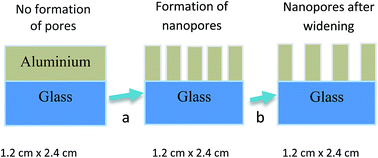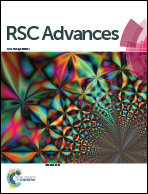Infiltration of VOPcPhO into porous alumina template grown by in situ method
Abstract
In this study, the fabrication of in situ anodic alumina template (AAO) directly onto glass substrate is realized by varying stirring speeds and molarity of phosphoric acid. Porous alumina template is used to infiltrate vanadyl 2,9,16,23-tetraphenoxy-29H,31H-phthalocyanine (VOPcPhO) prior to formation of the alumina:VOPcPhO nanocomposite. VOPcPhO was observed to fully infiltrate the template with excess formation of the VOPcPhO layer on top of the porous template after lengthy immersion of 6 h. Uniformity and density of pore size, and available pores, can be respectively tuned by varying the stirring speeds (0–300 rpm) and the molarity of the pore widening agent (0–10% of phosphoric acid). Rounded-sphere pore shapes observed with the higher transparency template were correlated with stirring speed at 100 and 200 rpm. At these speeds, the template's pore size and pore density are highly homogeneous. Changing molarity of phosphoric acid as a pore widening agent affected pore size and density. The occurrence of merging pores was observed upon increasing agent molarity to 10%, which was unlikely at the lower molarity of 5% phosphoric acid. Optical properties of alumina:VOPcPhO nanocomposites that were identified via characterization of UV-vis, photoluminescence (PL) and Raman spectroscopies support successful infiltration of VOPcPhO. Alumina:VOPcPhO nanocomposite has the ability to absorb light at longer wavelengths and photons are emitted by the nanocomposite at respective energies.


 Please wait while we load your content...
Please wait while we load your content...